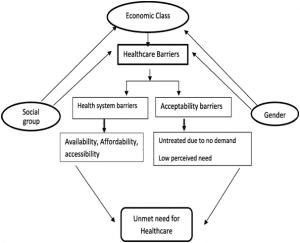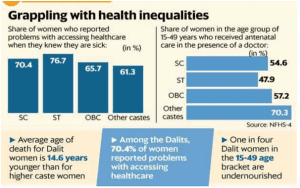THE CONTEXT: Among the many initiatives taken around the world to neutralize the gender binary, India faces its own challenge in the form of gender-caste intersectionality.
THE ISSUE: In the 2022 Gender Inequality Index, India ranked 135 out of 146
nations (United Nations Development Program (UNDP), 2019). India has both low rates of female labour force participation (FLFP) and large pay disparities between women and men in India. The FLFP is about 25% in rural regions and less than 20% in urban areas (Lahoti and Swaminathan 2016). The average wage of female employees is about 65% of the average male wages in 2018-2019 (Chakraborty 2020). Aside from the steps taken to improve women’s political representation, no constitutional mandate or law ensures seats for women in public-sector employment or educational institutions. Only a few states – like Bihar, Gujarat, Madhya Pradesh, and Punjab – have introduced reservations for women in government jobs during the last decade. In terms of educational institutions, the Indian Institutes of Technology (IITs) introduced a reservation of 20% seats for women in 2018 to correct the low levels of female participation in STEM (science, technology, engineering, and mathematics) disciplines. This measure has been quite successful in increasing the share of women, from about 14% of total seats in 2018-19 to 20% in 2020-21. Yet, a large gulf remains in achievement by the subaltern caste.
WHAT IS INTERSECTIONALITY?
The intersectionality perspective emphasizes that an individual’s social identity influences the individual’s beliefs and experiences of gender making it essential to understand gender within the context of power relations.
SOME OF THE EXAMPLES
Intersectionality of class, caste and gender and its linkages with unmet need for care. Research on economic inequality and poverty demonstrated that unequal distribution of resources manifests in unequal access to opportunities, including healthcare. Economic differences may not shape the opportunities in isolation rather than caste inequalities and

Gender biases which are rooted in the social system and interact with economic class, influence the pathways of healthcare access; some of the data in the case of gender intersectionality.


This clearly shows that a social gradient to health exists in India in the case of health outcomes.
The social gradient in health is a term used to describe the phenomenon whereby people who are less advantaged in terms of socioeconomic position have worse health (and shorter lives) than those who are more advantaged.
THIS INTERSECTIONALITY PREVAILS IN OTHER SECTORS TOO
- One of the RTI reports reveals that just 19% of the 17,000 companies had adopted the voluntary code of affirmative action for SC/ST communities. The hesitation of corporates in giving importance to caste-based hiring comes from their preference for talent over inclusion.
- However, the need for inclusion is imperative. Despite higher education systems providing placement opportunities to Dalit students, their scarce presence in corporates’ higher management across the country is worrying.
- Many of the leaders of top companies in India have been vocal about their willingness to hire based on merit and academic performance instead of caste.
- At the same time, a few companies like Muthoot ask for the caste of candidates in the application form.
- A study conducted in 2012 found that over 93% of the Indian Corporate board members belong to the “upper castes”. In such a scenario, the unconscious bias of companies and especially the recruiters can hardly be ignored.
- It has been observed that most of the Dalit workers in the private sector are employed at ground level and often as unskilled labourers. The absence of Dalit members in the management body directly impacts these lower-level employees.
- As a marginalized section, their needs and concerns remain unheard of and unresolved. This creates the condition of underrepresentation at the top level and overrepresentation at the bottom level.
- Impact of such anomaly.
- Impact on entrepreneurship: Dalit entrepreneurship has suffered due to a lack of resources as well as skills. The combined support of the government and the corporate houses is needed to boost such an entrepreneurial spirit. It is crucial to fill the gaps left by the education system through systematic training and skill development. Business houses such as Godrej and M&M are providing training facilities as well as funds to the deprived class entrepreneurs. The government has also been talking about bringing in equal opportunity legislation in the private sector along with financing for the training costs of underprivileged meritorious youth.
THE WAY FORWARD
- The Union Ministry of Minority Affairs came out with a “diversity index” that measures the workforce’s diversity in an organization. It has been found through several studies that the more diverse companies perform better financially, and consumers prefer them over those that take no stand on societal issues. Consequently, many companies have now started caste-profiling their employees. The need of the hour is a conscious effort from the corporate industry for inclusive hiring and talent development rather than just a few short-term CSR activities.
THE CONCLUSION: Despite caste-based reservations, caste-based discrimination persists, raising the question of whether alternative approaches to implementing affirmative action – other than reservations – should be considered.An alternative affirmative action strategy to reservations may be to devote more educational resources to prepare underrepresented groups for higher education students better.This approach may enhance representation while reducing negative stereotypes that women and lower caste groups have lower productivity or provide lower quality services. Enhanced representation and reduced discrimination against women and lower caste groups in high-skilled occupations can encourage competition and improve the overall quality of services.
QUESTIONS TO PONDER
- Deprivation cannot be reduced to one category of one social limitation. In this context, analyze the multifarious nature of deprivation in India.

